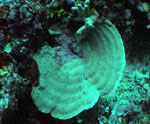
Maro Reef
(Ko‘anako‘a)
 Maro Reef is the largest coral reef in the Northwestern Hawaiian Islands, with over 1,934 square kilometers (approximately 746 square miles or 478,000 acres) of reef area. Unlike the classic ring-shaped atoll, Maro is a complex maze of linear reefs that radiate out from the center like the spokes of a wheel. It is named after the whaling ship Maro, which traveled these waters in 1820.
Maro Reef is the largest coral reef in the Northwestern Hawaiian Islands, with over 1,934 square kilometers (approximately 746 square miles or 478,000 acres) of reef area. Unlike the classic ring-shaped atoll, Maro is a complex maze of linear reefs that radiate out from the center like the spokes of a wheel. It is named after the whaling ship Maro, which traveled these waters in 1820.
Marine habitats of Maro Reef range from sandy lagoons to steep reef slopes, large coral heads, ocean pinnacles, and patch reefs. Gaps in the reef cause waves to sweep into the lagoon clouding some areas with silt and sand.
 Maro Reef is very large and hard to navigate, making it difficult for scientists to study. Historic sailing vessels found the area equally treacherous, and castaways lost at Maro Reef were forced to set out to the northwest in search of Laysan Island. Maro Reef has a greater abundance and diversity of coral than most any other reef system in the NWHI chain with thirty-seven species of stony corals documented by coral scientists during the 2000-2001 NOWRAMP Research expeditions.
Maro Reef is very large and hard to navigate, making it difficult for scientists to study. Historic sailing vessels found the area equally treacherous, and castaways lost at Maro Reef were forced to set out to the northwest in search of Laysan Island. Maro Reef has a greater abundance and diversity of coral than most any other reef system in the NWHI chain with thirty-seven species of stony corals documented by coral scientists during the 2000-2001 NOWRAMP Research expeditions.
 Many areas of the reef, particularly on the west side, have a large number of coral species, including rice corals, Montipora capitata and finger corals, Porites compressa. Maro Reef has a large amount of the hard, pink crusty algae that grows on coral called "coralline algae" that acts like cement and holds the coral together in high surf. The reefs support numerous butterflyfish and surgeonfish species. Large ulua and omilu have been seen in the reef's open waters, along with white-tip and gray reef sharks. Large schools of six to eight foot Galapagos sharks are also a common sight in the reef's shallow waters.
Many areas of the reef, particularly on the west side, have a large number of coral species, including rice corals, Montipora capitata and finger corals, Porites compressa. Maro Reef has a large amount of the hard, pink crusty algae that grows on coral called "coralline algae" that acts like cement and holds the coral together in high surf. The reefs support numerous butterflyfish and surgeonfish species. Large ulua and omilu have been seen in the reef's open waters, along with white-tip and gray reef sharks. Large schools of six to eight foot Galapagos sharks are also a common sight in the reef's shallow waters.
 Some researchers believe that, while Maro Reef has very healthy reefs, it may be "on the verge of drowning" because the reefs are narrow, unconnected, and unprotected from storm waves. Others feel that the health of the corals suggest that Maro Reef is a complicated reef system on a large seamount, living in balance with the elements.
Some researchers believe that, while Maro Reef has very healthy reefs, it may be "on the verge of drowning" because the reefs are narrow, unconnected, and unprotected from storm waves. Others feel that the health of the corals suggest that Maro Reef is a complicated reef system on a large seamount, living in balance with the elements.


